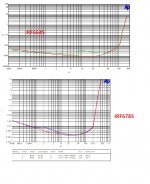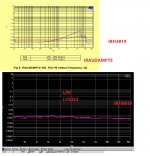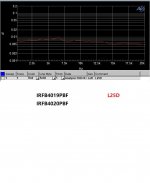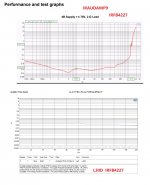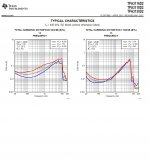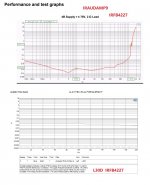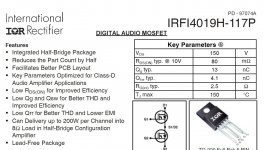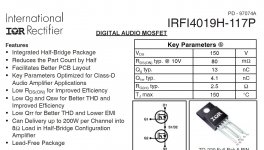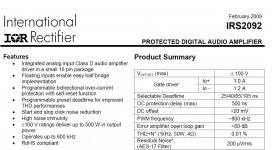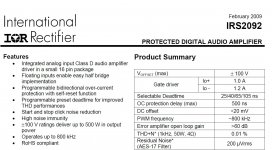Performance ranking of CLASS D power amplifier MOSFET.
LJM personal opinion. For reference only.
I will rank by performance index. Mainly thd+n. Instead of ranking by power.
Add some test data by the way. For reference.
I mainly use IR here. Infineon as a reference.
Other manufacturers will not do it for the time being.
NO1 IRF6645 0.004% THD+N 60W 4R(IRAUDAMP4S, IRAUDAMP5)
NO 2 IRF6785 0.005% THD+N 125W 8R( IRAUDAMP6)
NO 3 IRFI4019H, IRFI4020H 0.007% THD+N 60W4R ( IRAUDAMP7S) 【L15D,L15DSMD, L20D,L15DX2]
NO 4 IRFB4019PBF, IRFB4020PBF 0.009 THD+N 125W 8R (L15DPRO, L25D]
NO 5 IRFB4227 0.07 % THD+N 600W 2R( IRAUDAMP9, L30D)
LJM personal opinion. For reference only.
I will rank by performance index. Mainly thd+n. Instead of ranking by power.
Add some test data by the way. For reference.
I mainly use IR here. Infineon as a reference.
Other manufacturers will not do it for the time being.
NO1 IRF6645 0.004% THD+N 60W 4R(IRAUDAMP4S, IRAUDAMP5)
NO 2 IRF6785 0.005% THD+N 125W 8R( IRAUDAMP6)
NO 3 IRFI4019H, IRFI4020H 0.007% THD+N 60W4R ( IRAUDAMP7S) 【L15D,L15DSMD, L20D,L15DX2]
NO 4 IRFB4019PBF, IRFB4020PBF 0.009 THD+N 125W 8R (L15DPRO, L25D]
NO 5 IRFB4227 0.07 % THD+N 600W 2R( IRAUDAMP9, L30D)
Last edited:
Class D amplifier is not digital. It use PWM but also use negative feedback.
Distortion only can not tell how good the amplifier. At least you should measure IM distortion.
Distortion only can not tell how good the amplifier. At least you should measure IM distortion.
I think I want to tell others what I know.Class D amplifier is not digital. It use PWM but also use negative feedback.
Distortion only can not tell how good the amplifier. At least you should measure IM distortion.
And what others want to know. I don't know. So I can't answer others' questions for the time being.
For example, I can measure IMD distortion. This is not complicated. But I need to wait until I have time to do it.
yes. It may be a translation problem. We often call class D digital amplifier in Chinese.
In fact, this is a PWM amplifier. This is no problem.
There are also many industrial hexfets. For example, 20n series. IRFP2XX,
Their performance indicators are basically lower than irfb4227
Thd > 0.1. When I have time, I will measure it and give the data.
Their performance indicators are basically lower than irfb4227
Thd > 0.1. When I have time, I will measure it and give the data.
In addition. Almost all single power amplifiers have poor performance.
For example, tpa3116. ClassD powered by single power supply. It means that there is no negative voltage.
Therefore, its output will use BTL mode. Two inductors are required for each set of outputs.
Many of these products are used because there is no way to provide + - power supply. Such as cars. Such as USB audio equipment. Or mobile devices. Single power amplifier is not a product for hifi.
The sound box signal, sine wave, is always between + - power supply. Theoretically, performance can be maximized.
At HiFi
TPA3116 0.3% THD+N。
For example, tpa3116. ClassD powered by single power supply. It means that there is no negative voltage.
Therefore, its output will use BTL mode. Two inductors are required for each set of outputs.
Many of these products are used because there is no way to provide + - power supply. Such as cars. Such as USB audio equipment. Or mobile devices. Single power amplifier is not a product for hifi.
The sound box signal, sine wave, is always between + - power supply. Theoretically, performance can be maximized.
At HiFi
TPA3116 0.3% THD+N。
Attachments
This is an odd topic. I am not sure why different mosfets inherently generate IMD, but I can see how different ringing artifacts on the gate could easily interact with the gate drive to generate switching timing errors, which would cause some very unusual level dependent IMD
IRF6645 IRFI4019H IRFB4019This is an odd topic. I am not sure why different mosfets inherently generate IMD, but I can see how different ringing artifacts on the gate could easily interact with the gate drive to generate switching timing errors, which would cause some very unusual level dependent IMD
They are MOSFETs specially designed for digital power amplifiers by Infineon.
I believe Infineon engineers should understand. MOSFET required by digital power amplifier. And induction cooker. Or the requirements of switching power MOSFET are different.
Digital power amplifier needs better performance. Not more power.
of course. Don't care about digital amplifiers. Or the name of PWM.
Infineon also likes to call it digital amplifier. This is a matter of habit.
Attachments
of course. Don't care about digital amplifiers. Or the name of PWM.Class D amplifier is not digital. It use PWM but also use negative feedback.
Distortion only can not tell how good the amplifier. At least you should measure IM distortion.
Infineon also likes to call it digital amplifier. This is a matter of habit.
Attachments
The single supply operation is not the reason for the poorer performance.In addition. Almost all single power amplifiers have poor performance.
For example, tpa3116. ClassD powered by single power supply. It means that there is no negative voltage.
Therefore, its output will use BTL mode. Two inductors are required for each set of outputs.
Many of these products are used because there is no way to provide + - power supply. Such as cars. Such as USB audio equipment. Or mobile devices. Single power amplifier is not a product for hifi.
The sound box signal, sine wave, is always between + - power supply. Theoretically, performance can be maximized.
At HiFi
TPA3116 0.3% THD+N。
theoretically. OTL amplifier has poor performance. Because its output requires a capacitor.The single supply operation is not the reason for the poorer performance.
For example, jlh1969 frequency response. Thd is relatively poor. HiFi power amplifiers are basically OCL structures.
The digital amplifier has two single power amplifiers. Combined into +, - reverse amplification. BTL structure.
Theoretically, it does not need an output capacitor. Frequency response can be solved. Thd problem.
But in fact, there will still be problems. For example, the resistance of two inductors is much greater than that of one inductor.
And the PWM amplifier distortion will be added. Even the best in theory.
It is still impossible to be better than + - dual power amplifier.
That is + - dual power amplifier. At least it is the best power mode in theory for audio amplifier.
Although it may cost more. But I still think + - dual power supply is a necessary product.
If we can accept the amplifier whose performance is not very good.
Maybe cheaper.
Then why do we need DIY amplifier. Many cheap active multimedia speakers are also sufficient.
For example, TDA2030A can also meet hifi standard😛
There are digital amplifiers and analog amplifiers. Class D is analog.
If the data sheet states 'digital' for a class D, it's simply wrong.
Class D works with analog quantities, volts, amps, seconds.
A digital amp works with digital values, strings of 1's and 0's that represent values.
In technical discussions it is important to be clear in what you mean.
Too often we see here discussion go on and on because of sloppy use of terms and names.
If you look at the field you see that there are class D amplifiers that are better than even class A amplifiers.
Apart from the used devices, the main factor for 'quality' is the designer.
A class D amplifier designed by Bruno Putzeys for instance will perform better than 99% of amps out there.
Has little to do with the used parts, which are all bog standard, no boutigue parts.
My € 0.02.
Jan
If the data sheet states 'digital' for a class D, it's simply wrong.
Class D works with analog quantities, volts, amps, seconds.
A digital amp works with digital values, strings of 1's and 0's that represent values.
In technical discussions it is important to be clear in what you mean.
Too often we see here discussion go on and on because of sloppy use of terms and names.
If you look at the field you see that there are class D amplifiers that are better than even class A amplifiers.
Apart from the used devices, the main factor for 'quality' is the designer.
A class D amplifier designed by Bruno Putzeys for instance will perform better than 99% of amps out there.
Has little to do with the used parts, which are all bog standard, no boutigue parts.
My € 0.02.
Jan
Last edited:
You can write to Infineon. Tell them. Your PDF document is wrong.There are digital amplifiers and analog amplifiers. Class D is analog.
If the data sheet states 'digital' for a class D, it's simply wrong.
Class D works with analog quantities, volts, amps, seconds.
A digital amp works with digital values, strings of 1's and 0's that represent values.
In technical discussions it is important to be clear in what you mean.
Too often we see here discussion go on and on because of sloppy use of terms and names.
If you look at the field you see that there are class D amplifiers that are better than even class A amplifiers.
Apart from the used devices, the main factor for 'quality' is the designer.
A class D amplifier designed by Bruno Putzeys for instance will perform better than 99% of amps out there.
Has little to do with the used parts, which are all bog standard, no boutigue parts.
My € 0.02.
Jan
Digital amplifiers should not be used. Irs2092 should be written as an analog amplifier.
I think they may not reply to you.
Attachments
In my cognitive range. Almost all hifi dual power amplifiers.The single supply operation is not the reason for the poorer performance.
Can use a single power supply. But its performance is compared with that of dual power standard circuit. Performance is bound to decline.
For example, lm3886. And almost all hiend manufacturers' products. Without exception, dual power supply will be used.
Besides being cheap. Or there is no way. I can't think of a reason why a single power supply should be used for a home hifi amplifier. Or there are only batteries on the car
I can't think of a reason why a single power supply should be used for a home hifi amplifier.
A few off the top of my head - simplicity, cost, compactness, reliability, efficiency.
I view a true digital amplifier as a single bit power DAC, probably at too low clock and with all the idle tone noise issues that causes.
A true class-D has continuously variable duty cycle. Unfortunately real power mosfets take significant gate charge to switch and generate a lot of ringing noise on all the pins. This makes the real PWM - voltage curve ragged. NFB helps, but does not cure as at the detail level you may even get negative gain and therefore positive feedback. Actual implementation and layout is far more critical than with a Class AB
A true class-D has continuously variable duty cycle. Unfortunately real power mosfets take significant gate charge to switch and generate a lot of ringing noise on all the pins. This makes the real PWM - voltage curve ragged. NFB helps, but does not cure as at the detail level you may even get negative gain and therefore positive feedback. Actual implementation and layout is far more critical than with a Class AB
- Home
- Amplifiers
- Class D
- Performance ranking of CLASS D power amplifier MOSFET.
